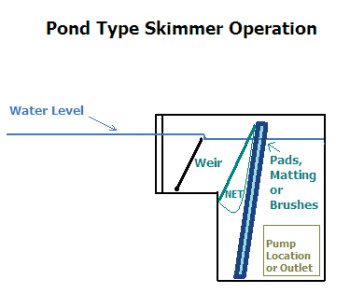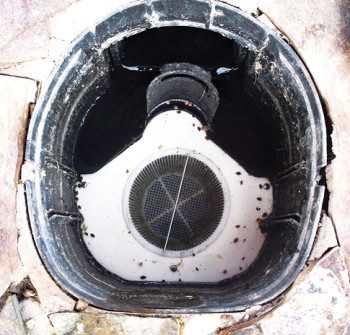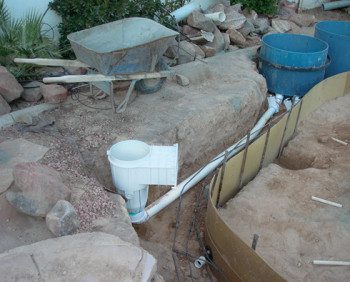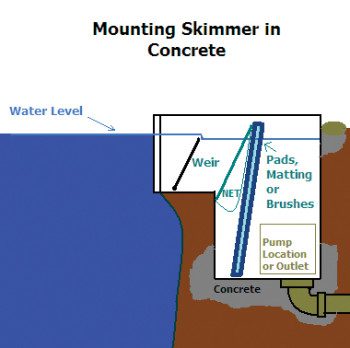- Home
- About Us
- Landscape
- Ponds & Water Features
- Portfolio
- Blogs
- Resources
- Contact Us
close

Our friend Kent Wallace the Filtration Guru has written many articles for Pond Trade Magazine and this is one of them. Enjoy! By Kent Wallace, Living Water Solutions
Published on February 27, 2015 in Pond Construction, Pond Equipment, Pond Tech 0
Determining the best skimmer for a particular project and how best to use it can be a challenge. Choices for skimmers come from both the water garden industry and the pool industry. The use of a pond skimmer started with water gardening as a way of moving the submersible pump out of the pond and into a protected space, away from the fish and plant debris. This created a form of pre-filtration with leaf nets and Japanese matting to separate out the larger debris ahead of the pump.
The primary job of a skimmer is to pull the large, floating debris off the surface of a pond before it has a chance to saturate and settle to the pond bottom. Ponds also generate a film on the surface created by oils from plant debris, fish, food, dissolved organics, et cetera. Even a pond that is completely protected from the elements can produce this film, creating a dingy look to the water’s surface. A properly functioning skimmer pulls this film off, keeping the surface clear.
A skimmer works with the use of a weir: a floating door that pivots at the bottom with a top edge that is suspended just below the surface of the water. The incoming water is forced over the top edge, creating a high level of tension at the water’s surface. The closer the weir edge is to the surface, the better it will create this surface tension. There are many types of weirs, but they’re all designed around the same goal: removing surface debris.
Many water garden skimmers create poor surface tension and have poor skimming ability due to a weir with little buoyancy or side channels that open up to the skimmer’s interior as the weir opens with water flow. In “skimmer only” ponds that don’t incorporate other water outflow types like bottom grids, bottom drains or mid-water drains, this isn’t a big issue because all of the water exiting the pond goes through the skimmer intake in a high volume. In systems where other outflow sources are in place, however, a better weir is necessary to allow the skimmer to actually do the job of skimming and not just act as an upper water outlet.

Skimmers always contain some type of trapping system to catch the debris as it passes through. Water garden skimmers have a net or a basket to catch the large debris and then have a system of pads, matting or brushes to trap the finer particles and do some initial bio-conversion. Water garden skimmers also have a large area to contain a submersible pump and, in general, are not designed for more efficient external pump systems. Pool-type skimmers house just a basket because there is no bioconversion or fines filtration that needs to be done in the skimmer and because swimming pools don’t use submersible pumps. Each has advantages and disadvantages and all can be modified to some degree to meet the needs of a koi pond.
Koi ponds don’t require skimmer water for the entire turnover rate as water garden skimmer systems do. Although submersible pumps can be used, direct suction to an external pump is generally preferred because of external pumps’ increased efficiency. With water garden skimmers, direct suction can be accomplished using the internal filtration of the skimmer as the prefiltration system, protecting the pump from debris. Add a bulkhead for a 2-inch or larger line directly from the back or bottom of the skimmer to the pump and you’re ready to go. The unused space where the submersible pump would have gone can be utilized by adding more media for increased prefiltration.If prefiltration is handled down-line, a plate can be designed to fit the shape of the skimmer housing and inserted in place to hold additional pool-type baskets for a higher flow rate. These can be used in conjunction with the original basket or net or as stand-alone baskets. Modifying water garden skimmers in this fashion allows for much larger debris-trapping ability and longer maintenance intervals between cleaning.
Pool skimmers can be plumbed directly to the front of an external pump, but a prefilter between the skimmer and pump is advised to pull out the heavy solids before the pump. Gravity flow to a prefiltration tank is the better method because the prefiltration tank can be larger and more effective. This can be accomplished with the addition of 3-inch or 4-inch bulkheads for larger lines between the skimmer and pre-filter. Pool skimmers are designed for direct suction-to-pump operation and usually have 1.5-inch or 2-inch outlets. These small outlets are highly restrictive and not suitable for gravity-flow systems, which require 3-inch or 4-inch piping. Gravity-flow application can be achieved by cutting off the lower portion of the skimmer body and adding an adaptor for either 3-inch or 4-inch.

One advantage of a pool skimmer is the smaller footprint and lid. Pool-type skimmers are a good option when space at the pond’s edge is limited, such as in the side of a raised pond or in a corner. Pool skimmers are much easier to work with aesthetically, and the vinyl liner versions have a mechanical clamping faceplate for use with pond liner or spray-applied coatings such as polyurea. Wide-mouth versions are also available, but aren’t necessary because it is the actual throat size that is important and not the tapered inlet shape to the face.Series | Best Pond Practices: This is an installment of an ongoing, multi-part series. Read last month’s installment, Bitofiltration | Let Bacterial do the Work
Never leave the basket out of a skimmer. This can be dangerous for fish, and the floating debris must still be removed by hand from the pre-filter tank.
Three pool skimmers on the market have a large basket and are very suitable for pond application. The one with the largest basket and the largest throat size (9.5 inches) of any pool-type skimmer is made by Waterco. This skimmer also comes with a beige lid assembly, which makes a pleasing blend with landscape or top cap easier. The Waterway Renegade series also has a large basket version, and the Pentair Bermuda skimmer has a large basket and also comes in black. The larger basket and gravity flow to prefiltration make these good choices for more formal applications.

Another skimmer option is the “Aqua Niche” skimmer. This is a free-mounting skimmer that is supported by a pipe directly in the pond and incorporates a floating, circular weir. A floating, circular weir is the most “fish-safe” design currently on the market. The circular weir’s shape actually has a weir lip approximately 15 inches in circumference and floats extremely close to the surface. This creates a very high level of surface tension because of the thin water line it pulls from the surface. The circular weir is also fish-safe because it floats up and down vertically and doesn’t pivot like a conventional weir that can trap a fish. This is safe for even small koi or goldfish when the water flow is kept at a reasonable rate. The Aqua Niche uses a large, B-37 basket
and comes with a 1.5-inch side outlet or a 2-inch, 3-inch or 4-inch bottom outlet.
The newest skimmer on the market is the Helix skimmer, which uses the circular weir technology in an external housing. The circular weir can be adapted to other pool-type skimmers, and eliminating the conventional weir door by the use of a retrofit kit makes them more fish-safe.
Many conventional weir skimmers have been modified to accept horizontal bars just below the water level as “fish guards.” Fish-guard bars should be mounted horizontally and not vertically to allow debris to flow under and over the bars without getting caught. Most of the skimmers I have replaced over the years have been crushed in by the surrounding soil over time. A concrete collar around the surface perimeter can prevent this and is a good practice to put in place when possible. Many pond skimmers get distorted by soil movement created by landscape growth and human traffic.
Fasteners for skimmer faces, as in all pond-related devices, should be stainless steel or plastic. Some popular commercial pond skimmers come with fasteners that are not stainless steel and begin to rust in a matter of days after installation. Be cautious with these fasteners and replace them when you come across them. Stainless steel nuts and bolts are readily available and will prevent fastener failure and the necessary replacement later on. The practice of installing a bottom drain line into a skimmer has become popular recently. This is largely an unsuccessful marketing ploy—and a waste of time unless done properly.
A bottom drain line into a skimmer is a gravity-flow concept. A 2-inch line will gravity-flow approximately 900 gph with a 1-inch difference between the pond surface level and the water level in the container to which it flows. A 3-inch line will flow approximately 1,800 gph with a 1-inch difference. It is virtually impossible to create a 1-inch difference in a skimmer, although a smaller level of difference can be achieved if done properly. The internal water level drop requires a restriction at the skimmer face and a relatively high flow rate from the pump. The skimmer weir opening must be kept small to restrict the flow and the weir must be very buoyant.
One of the best weirs for this is the old-school bellows weir, thanks to its stiffness. The drain line should be at least 3-inch in any but the smallest of pond systems. While a 1-inch drop is difficult to achieve, a half-inch to quarter-inch drop is achievable. A half-inch drop will allow a flow rate of approximately 900 gph through a 3-inch line. The drain line inlet should be in front of the pads or matting in the skimmer to protect the pump from pond bottom debris, and the line should have a cleanout plumbed into it for regular maintenance. The skimmer door can also be closed for a few seconds each week, forcing all the water possible through the drain line in an effort to flush the line and keep it flowing.
Choosing the right skimmer starts with proper placement and flow. Then considerations are made for fish safety, debris volume, ease of maintenance and aesthetics. Knowing your options makes the skimmer installation fit your pond’s particular needs.
